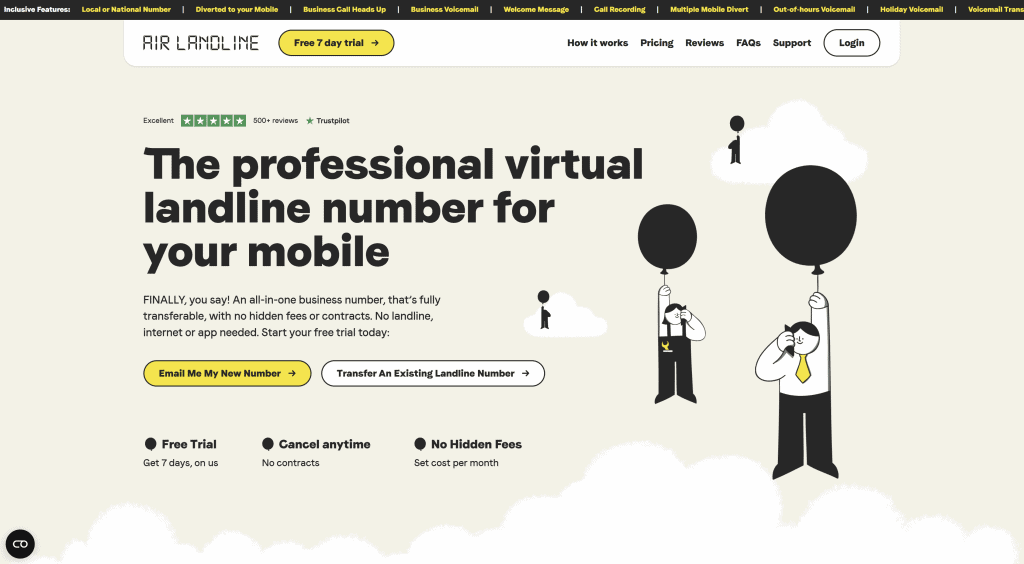Last Updated on February 2, 2025

The telephone remains a cornerstone of both business and personal communication.
While the basic concept remains the same, phone technology has evolved dramatically, offering a range of options from traditional analogue lines to cutting-edge digital solutions.
To help you find the perfect fit, we’ll explore the different types of telephone lines, covering everything from classic landlines to innovative VoIP services like Air Landline.
By understanding each technology’s strengths and weaknesses, you can confidently select the solution that best meets your needs.
List of Different Types of Telephone Lines
Most of us often take communication for granted. We effortlessly connect with people across the globe using mobile phones, video calls, and instant messaging.
But behind these seemingly simple connections lies a complex network of communication technologies and infrastructure that make it all possible.
Each type of telephone technology has its unique features and applications.
Understanding the nuances of these technologies will help you choose the communication solutions that best suit your individual needs and preferences.
Whether setting up a home office, managing a small business, or overseeing a large corporation, choosing the right telephone line can significantly impact your communication efficiency and costs.
Here’s a breakdown of the types of telephone lines we’ll be covering:
- Virtual Landline Numbers
- PSTN Business Telephone Lines
- ISDN Lines (ISDN2 and ISDN30)
- VoIP
- Multiline Systems
- On-Premise Telephone Systems
- Analogue Phone Lines
- Mobile Phone Networks
- Other Phone Lines (including Satellite Phones, T1 Lines, and PRI Lines)
Virtual Landline Numbers
A virtual landline number is a phone number that operates independently of any physical location or traditional telephone line.
It allows you to make and receive calls on your computer, mobile phone, or VoIP device, offering exceptional flexibility and portability.
With a virtual landline number, you can stay connected from anywhere with an internet connection, making it an ideal solution for businesses, remote teams, or individuals who are frequently on the move.
Beyond flexibility, virtual landline numbers contribute to a more professional image by allowing businesses to choose local area codes, even if they operate from different locations.
This can build customer trust, as callers will perceive the number as familiar and reliable.
Virtual numbers also offer ease of use with advanced features like call forwarding, voicemail transcription, and virtual extensions, making it easier to manage communications efficiently.
Furthermore, they eliminate the need for physical infrastructure, reducing overhead costs and enhancing operational efficiency.

Whether you’re a start-up, a growing business, or an entrepreneur, virtual landline numbers from Air Landline can help streamline communication while offering a professional, cost-effective alternative to traditional phone lines.
Some of the valuable features include:
- National and local numbers: Air Landline offers the flexibility to choose from a wide range of UK area codes. The availability of different area numbers allows businesses to establish a local presence in specific regions. This feature is especially beneficial for companies looking to build trust and rapport with local customers, regardless of their physical location.
- Call Forwarding: Air Landline can seamlessly redirect calls to any device, ensuring uninterrupted communication. Whether in the office, working remotely, or on the move, this feature guarantees that essential calls reach you wherever you are.
- Voicemail Transcripts: The voicemail transcripts feature enhances productivity. Transcribing your voicemails into text allows you to quickly scan through messages and respond more efficiently. It streamlines communication, saves time, and keeps you organised, all while improving your workflow.
- Call Recording: Air Landline’s call recording feature allows businesses to capture and store conversations for quality assurance, compliance, or training. This ensures high service standards and is a valuable tool for performance reviews and conflict resolution.
- Virtual Switchboard: The virtual switchboard feature enables professional call management with advanced tools like call transfer and Interactive Voice Response (IVR). This ensures that calls are routed efficiently to the right department or individual, enhancing customer experience and operational efficiency.
- And much more!
In short, virtual phone numbers from Air Landline are ideal for businesses seeking a cost-effective alternative to traditional phone lines. They ensure reliable communication at an affordable cost.
PSTN Business Telephone Lines
PSTN stands for Public Switched Telephone Network. It refers to the traditional network of copper wires used for phone communication for decades.
PSTN lines offer reliable voice communication and are often used by businesses that require a dedicated line for fax machines, alarm systems, or credit card terminals.
While PSTN lines are generally reliable, they can be more expensive than newer technologies like VoIP. Furthermore, PSTN infrastructure is gradually being phased out in some areas in favour of digital networks.
ISDN Lines
ISDN (Integrated Services Digital Network) lines deliver digital voice and data services over traditional copper telephone lines.
ISDN lines offer faster speeds and better quality than analogue lines. Businesses commonly use ISDN lines for video conferencing, data transfer, and high-speed internet access.
There are two main types of ISDN lines:
- ISDN2: Provides two channels, allowing for two simultaneous calls or a combination of voice and data.
- ISDN30: Offers thirty channels, making it suitable for larger businesses with high call volumes or significant data transfer needs.
While ISDN offers advantages over analogue lines, it is becoming less common with the rise of VoIP technology.
VoIP
VoIP (Voice over Internet Protocol) technology transmits voice calls over the Internet.
It converts analogue voice signals into digital data packets, allowing you to make calls using your computer, mobile phone, or a dedicated VoIP phone.
Another key advantage of cloud-based systems is the ability to integrate advanced features like voicemail transcription and call forwarding, which are not typically available with standard telephone lines.
As businesses move toward more modern solutions, the transition to cloud based systems is increasingly popular, giving businesses the ability to manage their phone numbers and communication needs from virtually anywhere, with fewer limitations and greater convenience.
Moreover, cloud phone number services can easily be scaled up or back, depending on changing business needs, making them a highly adaptable solution for businesses of all sizes.

Multiline Systems
Multiline systems are essential for businesses with multiple employees who must make and receive calls concurrently.
They provide a centralised system for managing incoming and outgoing calls, ensuring efficient communication and minimising customer wait times.
With features like call transfer, you can easily direct calls to the appropriate department or individual.
Moreover, call-holding capabilities ensure that callers are not disconnected while waiting for their call to be answered, enhancing customer satisfaction and professionalism.
Modern multiline systems often combine VoIP and cloud-based PBX functionalities.
This allows for greater flexibility and cost-effectiveness compared to traditional KSU or hardware-based PBX systems. However, these systems are more costly than single VoIP systems.
On-Premise Telephone Systems
On-premise telephone systems, also known as private branch exchange (PBX) systems, are comprehensive communication solutions housed within a business’s physical location.
This means the hardware responsible for managing calls, routing lines, and enabling features resides within your office space.
This setup gives extensive control over the business phone system.
These systems act as a central hub for all internal and external communications.
They manage incoming and outgoing calls, connect employees through internal extensions, and provide various features designed to enhance communication efficiency. These features often include:
- Call Transfer: Easily redirect calls to the appropriate department or individual.
- Voicemail: Provide a way for callers to leave messages when employees are unavailable.
- Call Conferencing: Host meetings with multiple participants, both internal and external.
- Call Queueing: Handle high call volumes efficiently by queueing callers until an agent becomes available.
- Interactive Voice Response (IVR): Automate call handling with pre-recorded messages and menu options.
While on-premise systems offer advantages in control and customisation, they also come with specific considerations.
The initial investment in hardware can be significant, and ongoing maintenance, including software updates and potential repairs, requires dedicated resources and expertise.
Businesses need to assess their needs, budget, and technical capabilities to determine if an on-premise system is the right solution for them.
Analogue Phone Lines
Analogue phone lines are the traditional type of phone line that transmits voice signals in an analogue format.
They are simple to use and widely available but offer limited features compared to newer technologies. Analogue lines are still used in many homes and small businesses.
Mobile Phone Networks
Mobile phone networks use radio waves to transmit voice and data wirelessly.
They offer portability and convenience, allowing you to make calls and access the internet virtually anywhere.
Mobile phone networks have evolved significantly, with technological advancements like 3G, 4G, and 5G offering faster speeds and improved call quality.
Other Phone Lines
Several other types of phone lines cater to specific needs:
- Satellite Phones: These phones use satellites to transmit signals, making them ideal for remote areas with limited or no cellular coverage.
- T1 Lines: These are high-capacity digital lines that provide dedicated bandwidth for voice and data transmission. They are often used by large businesses with high communication demands.
- Cloud-based phone systems: These allow you to access phone numbers from anywhere with an internet connection.
- SIP (Session Initiation Protocol). This is a signalling protocol used for initiating, maintaining, and terminating communication sessions that include voice, video, and messaging applications. It’s widely used in internet telephony, private IP telephone systems, and mobile phone calling over LTE (VoLTE).
- PRI Lines: (Primary Rate Interface) These lines are similar to T1 lines but offer more channels, making them suitable for businesses with very high call volumes
FAQ
This section addresses some common queries about telephone lines in the UK.
You can make and receive calls using your computer, mobile phone, or VoIP device without needing a physical phone line installed on your premises.
It allows flexibility and cost-effectiveness, particularly for businesses with remote workers or those seeking a more mobile solution.
ADSL (Asymmetric Digital Subscriber Line): This technology uses existing copper telephone lines to deliver broadband internet access.
It offers different speeds for uploading and downloading data, with download speeds generally being faster. ADSL is widely available but can be affected by distance from the telephone exchange.
FTTC (Fibre to the Cabinet): This technology combines fibre optic cables with copper wires. Fibre optic cables run to a street cabinet, and the final connection to your premises is made using copper wires. FTTC offers faster speeds than ADSL but can still be affected by distance from the cabinet.
FTTP (Fibre to the Premises): This technology uses fibre optic cables to connect your premises directly to the network. It offers the fastest speeds and most reliable connection as it eliminates the use of copper wires. FTTP is becoming increasingly available but may not be accessible in all areas.
Cable Broadband: This technology uses coaxial cables, originally designed for cable television, to deliver internet access. It offers high speeds and is less susceptible to distance limitations than ADSL or FTTC. Cable broadband is available in areas served by cable providers.
VoIP (Voice over Internet Protocol): This is a modern communication technology that transmits voice calls over the internet rather than through traditional telephone networks.
By converting analogue voice signals into digital data, VoIP allows users to make and receive calls using computers, mobile devices, or dedicated VoIP phones.
This technology is known for its cost-effectiveness, flexibility, and advanced features, such as video conferencing, call forwarding, and voicemail transcription, making it a popular choice for businesses and individuals alike.
Wooden Poles: These are the most common type, traditionally used for telephone and power lines.
They are made from treated timber, often Scots Pine, and are designed to withstand various weather conditions.
Metal Poles: Usually made from steel, these poles are more resistant to the elements compared to wooden poles and can support heavier loads.
Metal poles are often used in areas where extra stability is needed, such as in locations with high winds or heavy cables.
Concrete Poles: These are becoming more prevalent in newer installations.
They offer increased durability and longevity compared to wooden poles and are less susceptible to damage from rot or insects. Concrete poles are often used in areas with high wind loads or challenging terrain.
Check your phone bill: Your phone bill may specify the type of line you have.
Look for a dial tone: An analogue line typically has a continuous dial tone, while a digital line may have a different or intermittent tone.
Examine your phone socket. A digital line may have a different type of socket or additional connections than an analogue line.
Contact your service provider: Your telephone service provider can confirm the type of line you have and provide further details about your connection.
If you are unsure about the type of landline you have, contacting your service provider is always the best approach.
They can provide accurate information and assist you with any questions or concerns you may have.
Summary – Different types of telephone lines
Choosing the right telephone line depends on your specific needs and budget.
Consider factors like call volume, desired features, internet availability, and budget constraints when making your decision.
Understanding the types of telephone lines available will help you make an informed choice that ensures seamless and efficient communication for your home or business.
Try Air Landline free for 7 days and discover flexible, user-focused telephony services designed to simplify communication.